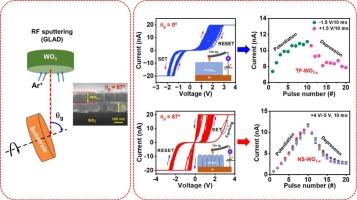Enhanced bio-synaptic plasticity behaviour through controlled defect migration in nano-columnar WO3−x memristors
IF 6.9
2区 材料科学
Q2 CHEMISTRY, PHYSICAL
引用次数: 0
Abstract
Two-terminal memristors have attracted significant research attention owing to their promising applications in non-volatile memory and brain-inspired neuromorphic computing systems. However, attaining reliable memristive and neuromorphic functionalities at nanoscale is essential for developing high-density, low-power devices designed for intensive data processing, posing a considerable challenge. In this report, we present a simple yet effective approach to attain superior bio-synaptic functionalities in tungsten trioxide (WO3−x)-based memristors at nanoscale by restricting the oxygen vacancy (VO) migration through compact nano-columnar structures developed using glancing angle deposition method. The restricted ionic migration is feasible owing to different VO concentrations inside the nano-columns and their boundaries, as inferred by nanoscale scanning probe microscopic techniques. The nanostructured-WO3−x memristors exhibit improved and reliable synaptic plasticity behaviours in comparison to their thin film-based counterparts when exposed to different pulse stimulations. Furthermore, the nanostructured devices demonstrate “experience-dependent plasticity,” where the synaptic plasticity is significantly influenced by the frequency of preceding pulses. In contrast, uncontrolled filament growth/destruction leads to a poor synaptic display in thin film-based WO3−x memristors. Moreover, various spectroscopic and electrical studies support the proposed physical mechanisms. Therefore, the present study paves the way to accomplish reliable synaptic functionalities at nanoscale for next-generation highly efficient neuromorphic systems.

通过控制纳米柱状WO3−x记忆电阻器中的缺陷迁移,增强了生物突触的可塑性行为
双端记忆电阻器由于在非易失性存储器和大脑启发的神经形态计算系统中具有广阔的应用前景而引起了广泛的研究关注。然而,在纳米尺度上获得可靠的记忆和神经形态功能对于开发高密度、低功耗的用于密集数据处理的器件至关重要,这提出了相当大的挑战。在本报告中,我们提出了一种简单而有效的方法,通过使用掠角沉积法开发的紧凑的纳米柱状结构来限制氧空位(VO)的迁移,从而在纳米尺度上获得三氧化钨(WO3−x)基忆阻器优越的生物突触功能。纳米级扫描探针显微技术推断,由于纳米柱内部及其边界的VO浓度不同,限制离子迁移是可行的。在不同的脉冲刺激下,纳米结构的wo3−x忆阻器表现出比薄膜型忆阻器更好和可靠的突触可塑性行为。此外,纳米结构的装置显示出“经验依赖的可塑性”,其中突触的可塑性受到前脉冲频率的显著影响。相反,在薄膜WO3−x记忆电阻器中,不受控制的丝生长/破坏导致突触显示不良。此外,各种光谱和电学研究支持提出的物理机制。因此,本研究为下一代高效神经形态系统在纳米尺度上实现可靠的突触功能铺平了道路。
本文章由计算机程序翻译,如有差异,请以英文原文为准。
求助全文
约1分钟内获得全文
求助全文
来源期刊

Applied Surface Science
工程技术-材料科学:膜
CiteScore
12.50
自引率
7.50%
发文量
3393
审稿时长
67 days
期刊介绍:
Applied Surface Science covers topics contributing to a better understanding of surfaces, interfaces, nanostructures and their applications. The journal is concerned with scientific research on the atomic and molecular level of material properties determined with specific surface analytical techniques and/or computational methods, as well as the processing of such structures.
 求助内容:
求助内容: 应助结果提醒方式:
应助结果提醒方式:


